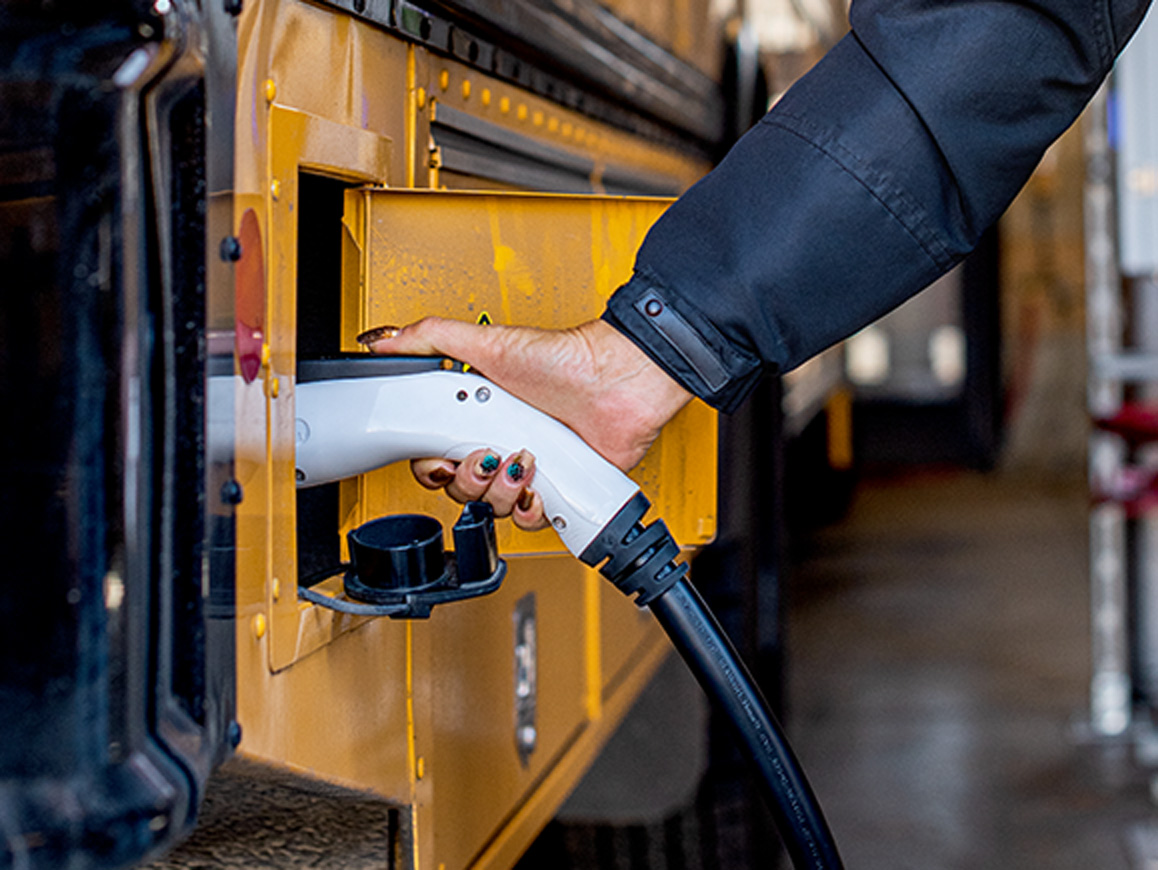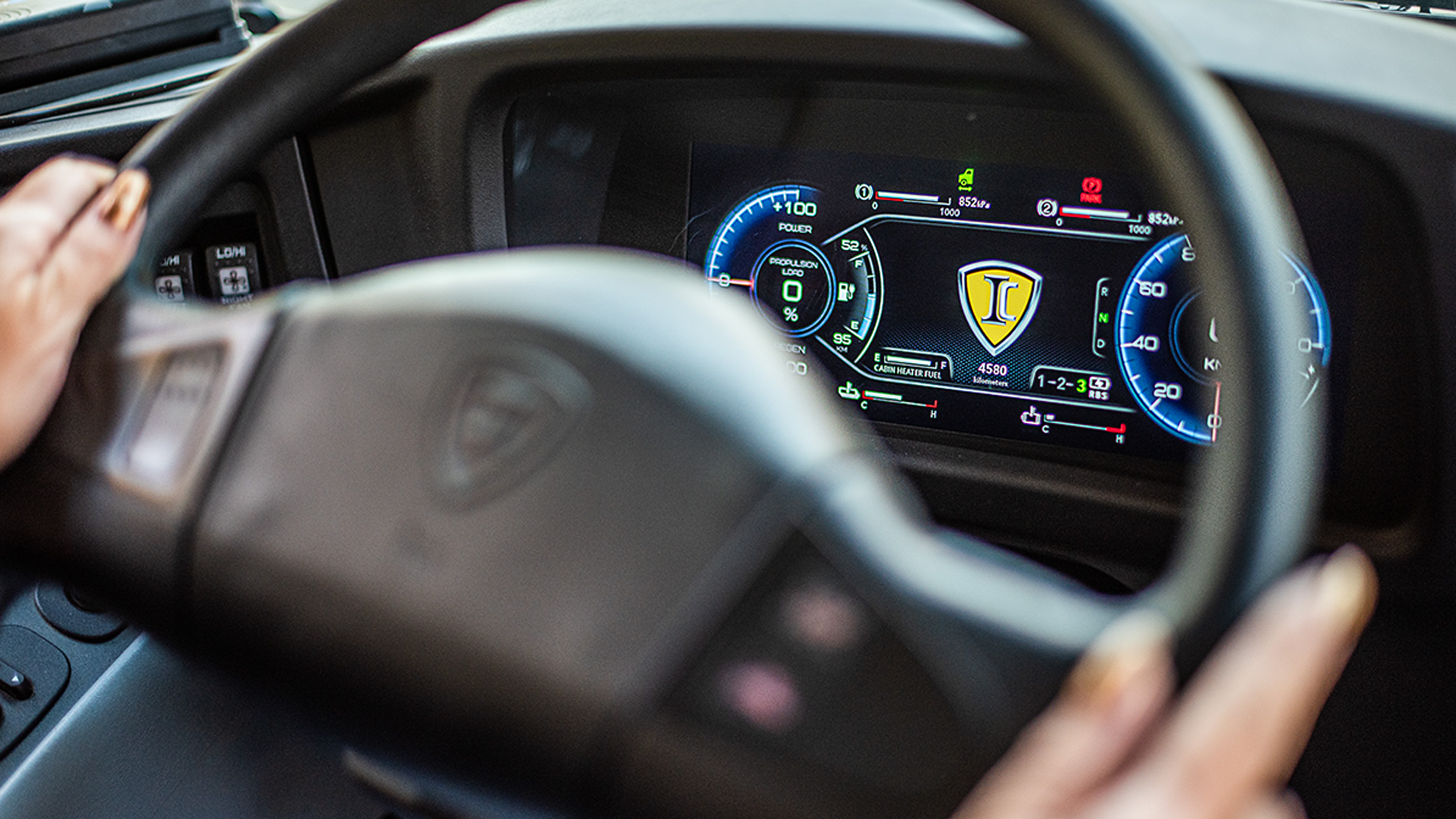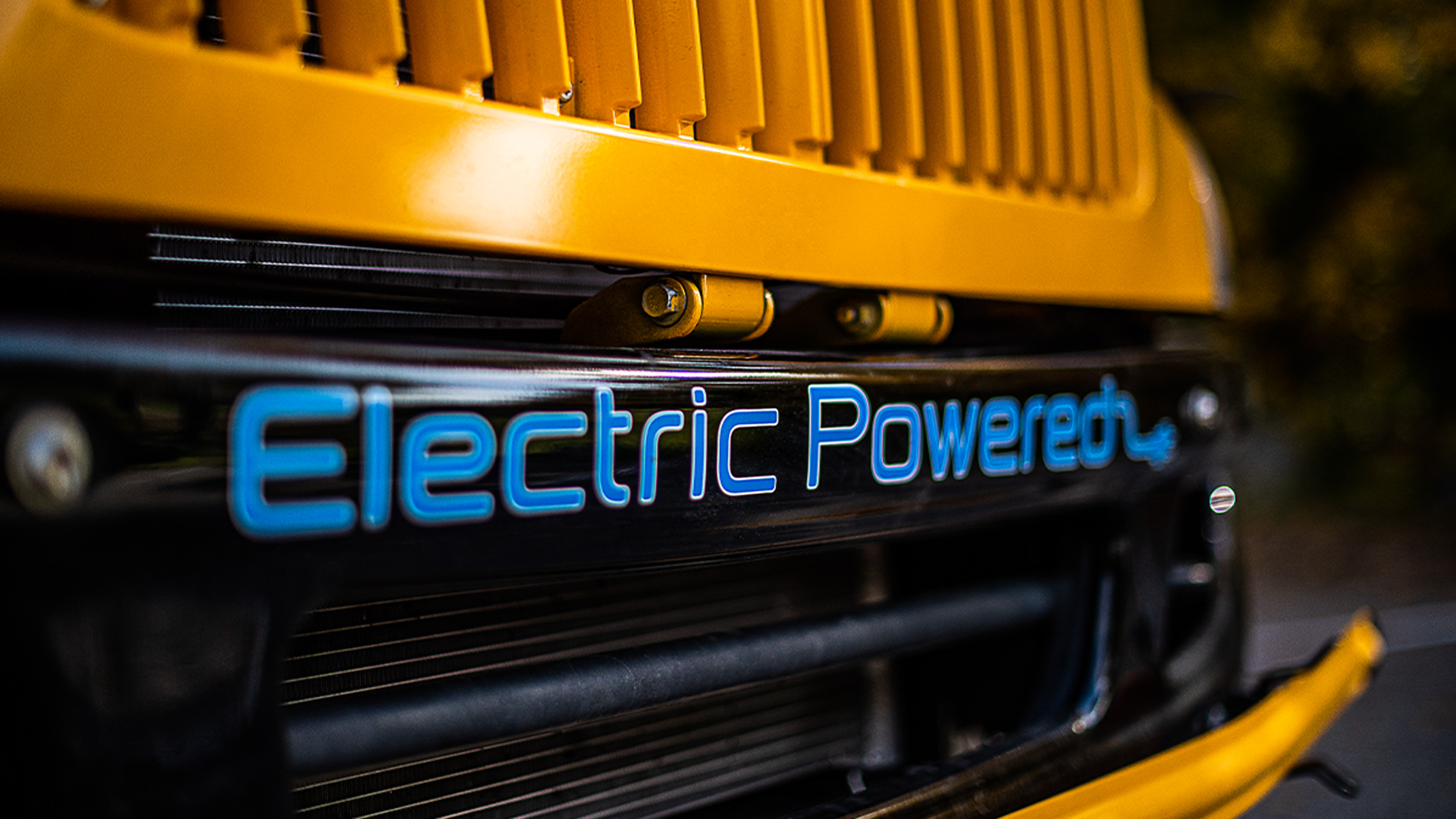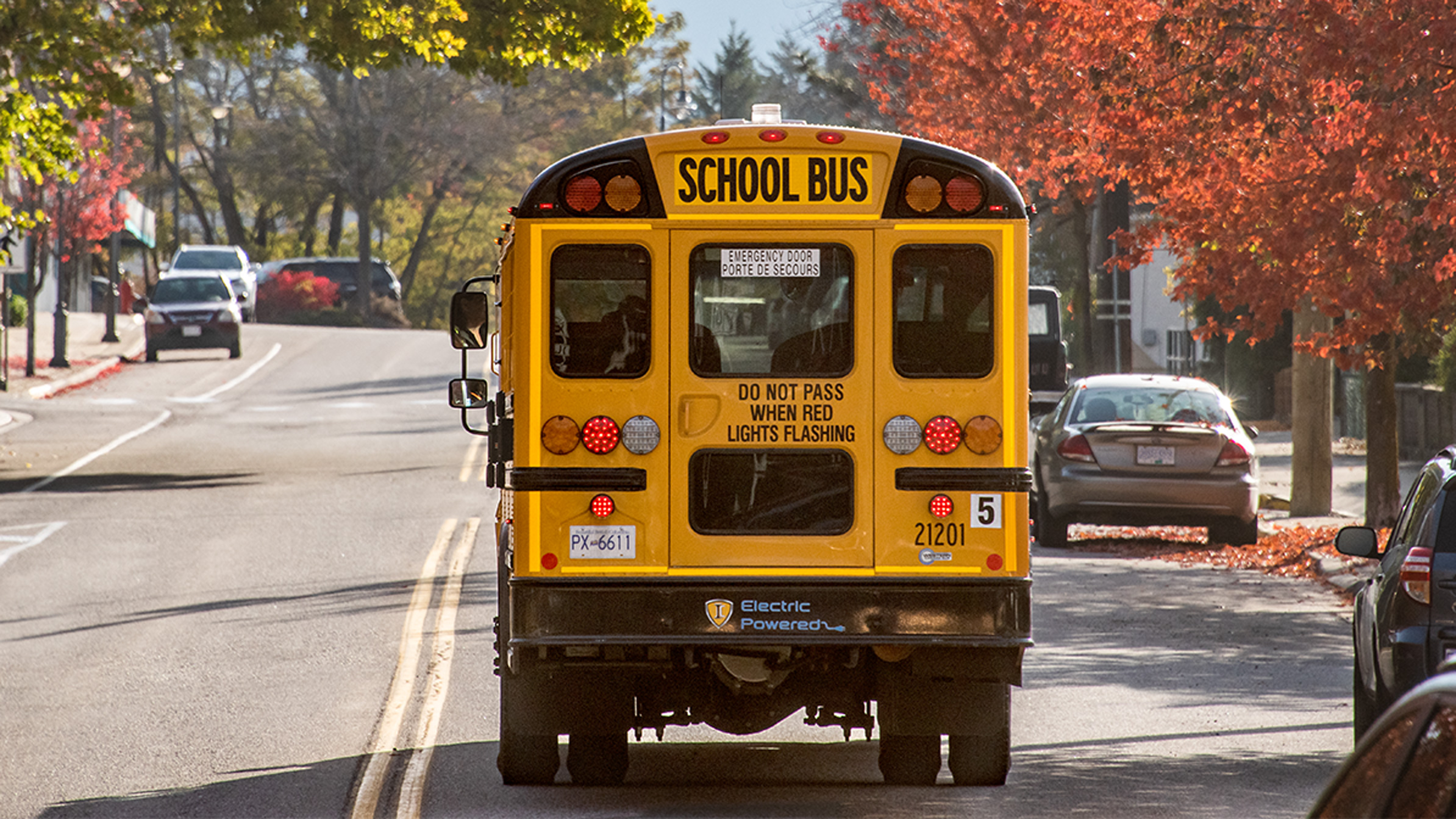Electric mobility has now reached the legendary yellow school buses in North America. Market leader IC Bus, which belongs to the TRATON GROUP brand Navistar, put its first all-electric buses on the road in mid-2021. How do people like them? Read on for a field report from a school district in Castlegar, located in the far south of British Columbia, just a few miles north of the US border.
Route 3 winds its way through mountainous terrain between the Canadian metropolises of Vancouver and Calgary. The surrounding hills are covered with dense forests, and now, in October, they radiate in colorful fall hues. Against this stunning backdrop, a brand-new school bus turns into the small town of Castlegar. The yellow CE series vehicle from IC Bus, with its traditional, iconic design, runs almost silently. A light whirring sound is all you hear. It is one of the first 18 all-electric school buses purchased for school district 20 in the province of British Columbia.
More than 3,000 school buses are sold in Canada every year. Most of them come from the US company Navistar and its IC Bus brand, which were incorporated into the TRATON GROUP in 2021 — the same year the North American market leader for school buses launched its first all-electric vehicles to the market.
“We’re transforming an entire industry, we’re building a whole new ecosystem that allows us to form closer and more sustainable relationships with our customers.”Jason Gies
Vice President, eMobility Business Development at Navistar
Closer customer relationships
“We’re transforming an entire industry,” Jason Gies declares enthusiastically. “In effect, we’re building a whole new ecosystem that allows us to form closer and more sustainable relationships with our customers.” Gies heads up eMobility Business Development at Navistar, which includes the development department for electric school buses. For him, building up this division is “an opportunity you only get once in a hundred years.”
To achieve this, Navistar’s NEXT eMobility Solutions group has launched its 5 C Strategy that ensures customers have a successful transition to electric vehicles. The five Cs stand for consulting, construction, charging, connectivity, and conservation.
What all of this means in practice becomes clear when you look at pioneers like Robert Brown, IC Bus Regional Sales Manager for Navistar Canada, and his colleague Cam Stauffer. As Technical Service Manager Stauffer traveled back and forth between Ontario and British Columbia in the midst of the COVID-19 pandemic to train the people in charge of school district 20. All the while, he had to stay up to date with the latest technology himself — in order, for instance, to develop an optimal charging and maintenance concept with the future users of the vehicles.

From the outside, the electric bus is hardly distinguishable from its diesel counterpart.

The charging infrastructure is part of the all-round package that comes with Navistar’s electric school buses.
It was no coincidence that the market launch took place in this very rural region of British Columbia. “We could have taken a simpler approach and started in Southern California, where the weather is always good and the population is already very eco-conscious,” Robert Brown explains. “But our team wanted to show that our product also works in a challenging environment.” The town of Castlegar, with a population of 10,000 and a vast catchment area that is almost completely devoid of electric mobility infrastructure, seemed ideal for this project. There are mountains to cross and bitterly cold winter months to get through.
Charging infrastructure as a major challenge
“If an electric bus can run reliably in Castlegar, it will run just about anywhere else,” Jason Gies confirms. A particular challenge was the charging infrastructure. “Our goal is to have the necessary charging stations in place before we even deliver an electric bus,” says Gies, “but that’s easier said than done.” Navistar needs partners to set up the charging stations, and in most cases, they are regional energy companies. “But we have to adapt to the local circumstances,” emphasizes Gies. “There is no standard solution.” For the future, the partners are also working on solutions that include solar panels, which would allow customers to produce their own electricity.
Long-term planning
The sale of electric school buses must be planned well in advance. “We tell customers: if you want to purchase electric buses in five years’ time, let’s start talking about charging now,” Gies explains. In addition to product support, Navistar also provides advice on subsidy opportunities. “We are familiar with the programs in each state and province,” Gies says. The subsidies make it easier for school districts to purchase electric buses, which are, after all, significantly more expensive than vehicles with an internal combustion engine.
However, school bus operators consider more than just the subsidy in their calculations. “The remaining extra costs of acquisition amortize quickly,” explains Lisa Phillips, a manager in the Transportation Department for school district 20. “By using electric vehicles, we save one of the main cost drivers: diesel fuel. The buses also require much less maintenance because they don’t have transmissions and there’s less wear and tear on the brakes, for example.” Navistar and IC Bus have developed new tools and maintenance processes to help with the upkeep. Plus, employees of the school district are being coached on electric drive technology, since only a few mechanics have been trained to work with high-voltage equipment.
3,000school buses are sold in Canada each year.

Carlie O’Brien has been driving school buses for 15 years and went electric a month ago. She says the new driving experience is “just fun.”
New soundscape
Lisa Phillips helped introduce electric buses for her school district in Castlegar. The 40-year-old is now in charge of fleet management, drivers, route planning, maintenance — in fact, just about everything. “The staff at Navistar really did a great job,” Phillips says. “They were always there to help us, planning with us for almost two years and training us to become electric bus specialists.” One challenge, for example, was the regulatory authorities, who had no standardized tests in place to approve electric vehicles.
But all the effort was worth it, because the buses have been received very well by users. “Our students love the new electric buses. They’re really proud to make a contribution to protecting the environment,” reports Phillips. The new soundscape is also fascinating: “During the first test drives, those of us inside the bus didn’t hear a thing when the motor started,” recalls Phillips. “Everyone wondered whether or not it was running.” Then the bus had to withstand an endurance test through the mountains — and passed with flying colors, as Phillips explains: “Even there, it managed to deliver the promised range of about 200 miles.” Carlie O’Brien has been driving the electric bus for a month; she just finished a tour to Castlegar. After 15 years in a diesel school bus, she can now testify to a whole new driving experience: “The vehicle is extremely responsive, the handling is easy, the braking system is fantastic — driving an electric bus is just fun.”
“The vehicle is extremely responsive, the handling is easy, the braking system is fantastic — driving an electric bus is just fun.”Carlie O’Brien
Bus Driver, School District 20, Canada
Recharging overnight
The buses are recharged overnight in Castlegar. This works very well and can even be monitored from Navistar’s eMobility office in Michigan. “We often joke that we don’t go to bed until we see all the buses out there at their charging stations,” Jason Gies says with a grin. Navistar’s medium-term goal is to deliver tens of thousands of buses per year. The capacity for this will be created at the production site in Tulsa, Oklahoma. “Unlike some of our competitors, we manufacture all of our vehicles ourselves,” Gies says. “Currently, we have vehicles with internal combustion engines and electric buses running in parallel on the production lines at the factory. But depending on how demand develops, we can scale up e-bus production at any time.”
Navistar
Navistar is the market leader for school buses in North America with its IC Bus brand. The market volume comes to around 30,000 vehicles per year in the USA and 3,000 in Canada, with IC Bus holding a market share of 44 percent in Canada and more than 37 percent in North America as a whole. Alongside the bus segment, which includes commercial buses as well as school buses, Navistar also has a second business segment: trucks marketed under the International brand. The company has set up its NEXT eMobility Solutions group to engineer zero-emission powertrains and lead the zero-emission business development for IC Bus and International Trucks. Navistar produces all of its vehicles and engines itself, with five production sites in Tulsa, Oklahoma; Springfield, Ohio; Huntsville, Alabama; Escobedo, Mexico; and soon-to-be-opened San Antonio, Texas. The company has been part of the TRATON GROUP since mid-2021.








.jpg/jcr:content/Teaser-Grafik-Tiva-Sharifi-3840x2560-V1-(1).jpg
)
.jpg/jcr:content/Teaser-Grafik-Mansoureh-3840x2560-V1-(1).jpg
)


